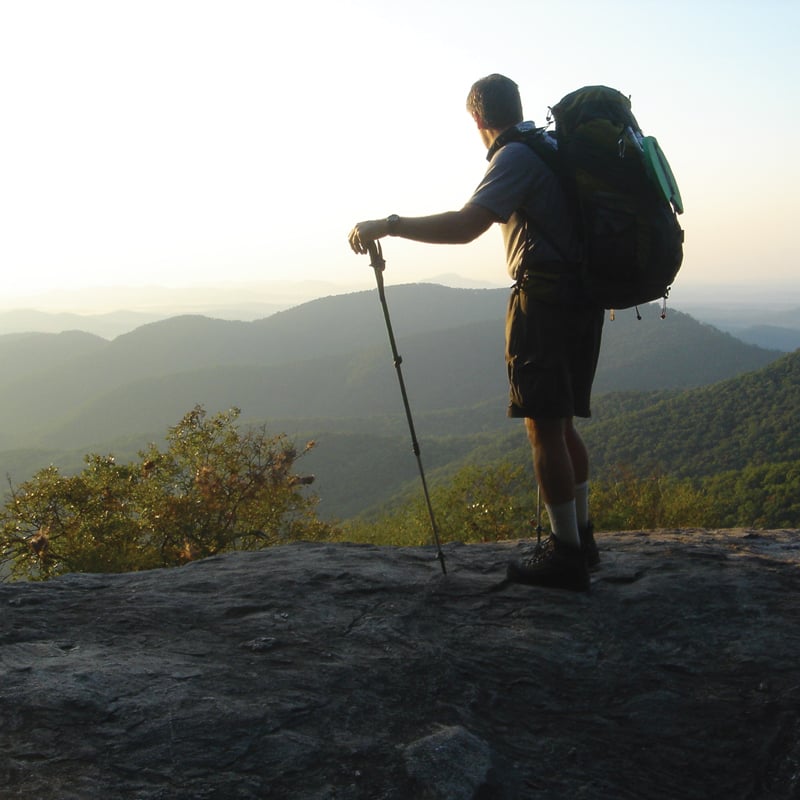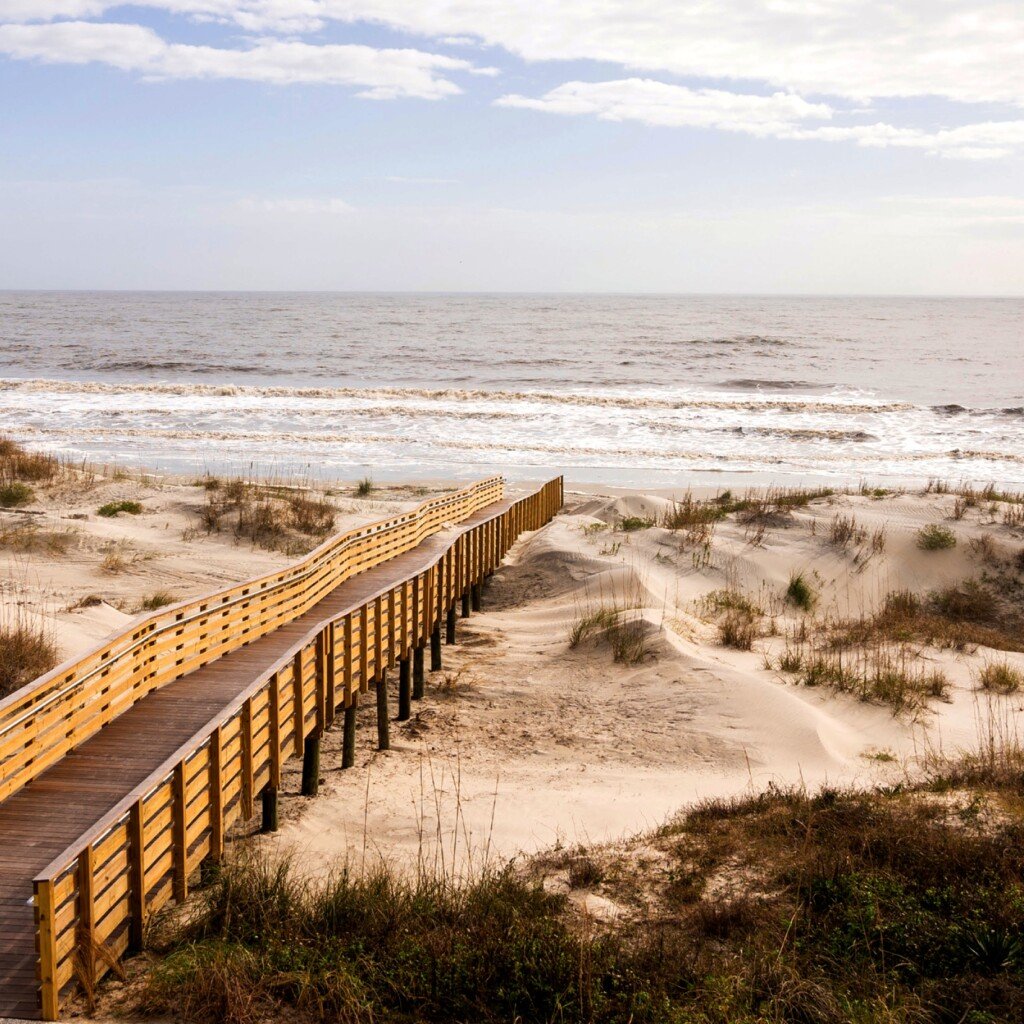Ecoadventures Abound in Georgia
Georgia offers countless opportunities to experience, learn about and help preserve natural environments.

Kayaks glide peacefully down Skidaway River, winding through pristine marshlands along Georgia’s coast, while a guide points out species of birds – including bald eagles, ospreys, pelicans, gulls, terns and cormorants – and explains why they need protection.
Up north near Dawsonville, eager hikers at Amicalola Falls State Park listen to a presentation about what they will encounter – and why following the rules is essential – before they begin their journey on the state’s 78-mile portion of the Appalachian Trail.
Nearly 400 miles south near Fargo, a ranger at Stephen C. Foster State Park talks to a family about the importance of conserving the nation’s largest blackwater swamp, the Okefenokee. His comments resonate as their boat slips past alligators sunning on fallen logs in the cypress-lined Minnie’s Run waterway.
These are just a few of the ecotourism opportunities that abound in a state rich in natural resources. Georgia’s 62 state parks, 11 national parks, 14 barrier islands, more than 860,000 acres of national forests and countless rivers and lakes offer a variety of sustainable recreation experiences.
What makes these adventures ecotourism?
“The consensus definition is that ecotourism is a form of environmentally responsible tourism that involves travel and visitation to relatively undisturbed natural areas, with the object of enjoying, admiring and studying nature,” says Bynum Boley, associate professor of parks, recreation and tourism management at University of Georgia (UGA). “There’s a lot of debate but [ecotourism] has to be nature-based. It has to be educational and then sustainably managed. So it’s really those three principles for it to be considered ecotourism.”
Not all outdoor recreation is ecotourism. “Just because it’s nature-based does not mean it’s ecotourism,” he explains. Along with the educational component, Boley says the sustainability aspect must be included. It refers to the impact on natural resources, the effect of visitation on the quality of life of people in the area and the local economic impact. “Those are all things that you would need to consider to say ecotourism has been sustainably managed,” he says.
The International Ecotourism Society was founded in 1990 and established its own definition and principles. But the nebulousness of the term has made it hard to quantify and it has yet to become a separate subset of state tourism statistics. The closest thing to an official accounting by the Georgia Department of Economic Development is research revealing that 5% of overnight visitors to the state in 2019 and 4% of day-trippers indicated that ecotourism was an activity of special interest to them on their trip. With nearly 151 million visitors, that means between 6 million and 7.5 million people were likely ecotourists that year.
Teachable Moments
Many of those ecotourists chose to visit state parks. “I’m proud to say that Georgia’s state park system is a primary source of ecotourism in our state,” says Jeff Cown, director of the State Parks and Historic Sites Division of the Georgia Department of Natural Resources. “We protect more than 84,000 acres of land and make it easy for citizens and visitors to enjoy and learn from nature.”
The parks stayed open during the COVID-19 pandemic, offering an outdoor escape where people could spread out while experiencing nature’s beauty and perhaps learning a few things. Some parks in North Georgia, like Cloudland Canyon, and those near Metro Atlanta became so popular in the past year that access had to be limited occasionally to prevent overcrowding and potential damage to fragile ecosystems. Cown says parks across Georgia hosted 11 million guests during the last fiscal year, an increase of more than 500,000 from the previous year.
Not everyone going to the state parks during the pandemic has been an ecotourist, since many of the interpretative programs, kids’ camps and other educational amenities were curtailed. But like other entities, the parks quickly developed new ways of connecting with visitors.
“Education is extremely important, and we put a priority on programming that teaches about nature, wildlife, clean water, cultures and other important aspects that contribute to ecotourism,” says Cown. “When the pandemic caused us to halt in-person programs, our rangers quickly adapted and created online videos, which can still be found on YouTube. Now, as more people are vaccinated and we can be socially distant outdoors, our rangers are beginning to offer more campfire programs, guided hikes, paddling trips and Junior Ranger programs.”
At Panola Mountain State Park southeast of Atlanta, Interpretive Ranger Erica Lanier leads groups of 12 on three-hour hikes, teaching her followers about the fragile monadnock ecosystem. Monadnock refers to a rock formation or small mountain that’s not surrounded by others. Arabia Mountain and Stone Mountain are the other two monadnocks in the metro area.
Panola Mountain is special because it’s “the only one that’s still preserved in its pristine or original condition,” she says. “That’s the reason that we have guided hikes – to ensure that it always stays in pristine condition. When we do our guided hike, we focus not only on the geological process that created the mountain, but also [on] how to read the landscape of the forest around you.”
Lanier and her hikers stick to a path well-worn over the past 50 years to avoid damaging vegetation. “We don’t realize how fragile some of our ecosystems are and the fact that the monadnock ecosystem can be damaged so easily,” she says. “A spore of a lichen grows to the size of a postage stamp in 25 years. But it takes no time at all for us to scrape it off with our feet. It’s important to understand how we as humans can have a sometimes positive or negative impact on our natural environment. And then understanding how we can prevent those negative impacts.”
She says the park is offering about 20 guided hikes per month – similar to before the pandemic – but the number of people on each hike is limited to half what it was. Because of that, advance reservations for the hikes have filled up quickly. Private group tours – like those for Girl and Boy Scout troops – have increased significantly.
The pandemic has also affected Lanier’s counterpart at Stephen C. Foster State Park, Interpretative Ranger Josh Snead. He’s been taking fewer people on boat tours of the Okefenokee National Wildlife Refuge. Previously as many as 17 might have been in the boat for an hour-and-a-half tour. Through this spring, the trips have been limited to one self-contained group, usually a family. He says advance reservations book up quickly and the park has tried to add tours to help meet the demand.
“Even though we can’t get as many people on [boat] tours, we’ve seen our booking for campsites and cabins go up,” he says. “We really haven’t seen much of a slowdown in terms of visitation throughout most of [the pandemic] except at the very beginning.”
Those he ferries are interested in the wildlife, especially alligators and barred owls. “You get these moments where people see an owl for the first time in the wild that’ll stick with them,” he says.
But for Snead, one of the best things about the boat trips is helping to reverse ecotourists’ often-negative perceptions of what a swamp is. “Going out on these tours is an opportunity to transform that negative sense into [one] that it really is a place full of life that’s uniquely beautiful,” he says. “I think the impression people walk away with is ‘this wasn’t what I expected, but it was better than I expected.’” He hopes the boat tours promote conservation so “maybe those same people can come back decades later, bring family, friends, grandkids, and find the place protected as well as it is today or better.”
Coastal Revelations
Boat and kayak tours are good ways to explore the unique environments of Georgia’s barrier islands, especially since only four – Jekyll, St. Simons, Sea and Tybee – are accessible by car. An online search of ecotourism companies along Georgia’s coast brings up Savannah Coastal Ecotours, operated by Kathryn and Fran Lapolla, who have educational backgrounds and deep connections with UGA’s Marine Extension and Georgia Sea Grant division.
The Lapollas started the business in 2014 when they retired and it’s “as much a labor of love as a real business,” says Kathryn. They offer a variety of boat and kayak trips through the marshlands and islands, including the Isle of Hope, Wassaw Island and Ossabaw Island where Fran acts as a part-time naturalist and host for the Ossabaw Island Foundation. Wassaw is a National Wildlife Refuge and Ossabaw is a State Heritage Preserve.
Fran estimates that pre-COVID, the two of them were taking roughly 600 to 700 people a year on ecotours. But the pandemic “knocked off about 75% of the business,” he says. Bookings are rebounding this year and the couple is optimistic about ecotourism continuing to grow. “I think more people old and young are getting out, discovering the fun and the adventure of doing more than shopping and eating when they travel to places,” says Kathryn.
“With the awareness of climate change, there are more people who are more aware of the whole ecosystem and how we relate to it than before,” Fran adds.
“One of the things we talk about [on tours] is how our coast offers important services that were not always understood, like storm protection or acting as a nursery for a huge percentage of our seafood animals,” says Kathryn. “People used to see these beautiful marshlands as more or less wasteland suitable only for draining and filling-in for housing.” She adds that as pressure to develop these fragile areas increases, ecotourism can help more people understand the real value of Georgia’s salt marshes, which comprise about a third of those remaining on the Atlantic coast.
Visitors looking for a true coastal ecotourism experience should research companies offering tours to make sure the education and sustainability components are part of the package. Since no real licensing exists for guides, Fran believes certifications are an important differentiator. “It’s good to set some standards and have people aware that certain individuals or companies follow these standards,” he says.
In addition to their naturalist and other certifications, the Lapollas recently completed the Coastal Awareness and Responsible Ecotourism certification program conducted by UGA Marine Extension and Georgia Sea Grant in partnership with Manomet Inc., a Massachusetts-based nonprofit dedicated to wildlife protection. The certification is designed for water-based tour companies, highlighting the important role Georgia’s coast plays for nesting and migrating shorebirds and how their fragile habitats can be protected. Eventually UGA will also develop a program for recertification, Fran says.
Trail Time
Traveling from low-lying marshes to the North Georgia Mountains highlights the vastly different ecotourism options available in the state. Visitors can experience breathtaking vistas that include waterfalls, forests and peaks touching the sky. The mountainous terrain and its ecosystem are unlike anything else in the state. Here, one of the biggest draws is the Appalachian Trail, which begins at
Springer Mountain and traverses 14 states before ending in Maine. Each year nearly 4,000 aspiring hikers begin their journeys in Georgia, with most using the eight-mile approach trail from Amicalola Falls State Park to get to Springer Mountain.
At the park, trail ambassadors from the Georgia Appalachian Trail Club educate would-be hikers twice a day with formal programs about the trail and ways to minimize their environmental impact.
“We’ve incorporated videos and everything else, but a lot of it is just talking one-on-one with people so they have a good understanding of what they’re about to undertake,” says Don Converse, a retired engineer who’s president of the club. “The emphasis is really on ‘leave no trace.’”
Along with giving presentations, trail ambassadors are stationed throughout the first 50 miles of the trail to answer hikers’ questions and provide assistance. In addition, the club offers small, guided day hikes for up to about a dozen people and helps maintain Georgia’s portion of the Appalachian Trail.
As a steward, Converse worries about the sustainability of the trail. “We are kind of in the same boat as any of the other national parks, which is it can be loved to death,” he says. “So far it has been sustainable, and I think we can probably accommodate quite a few more people before it becomes a critical problem.”
The Georgia Conservancy also hosts hikers – and paddlers and campers – on its Stewardship Trips throughout the state. This year, the group has held day hikes and paddles near Savannah and as far north as Lookout Mountain in addition to service weekends at a number of locations. The trips teach participants about location-specific conservation issues and opportunities for advocacy, furthering the conservancy’s goal of creating a connection between some of Georgia’s most precious places and individuals who can be protectors. Those people are much more likely to raise their voices and advocate for threatened environments and species if they have been ecotourists.
“Ecotourism is extremely important to our future,” says Cown. “Protecting natural and cultural resources, educating our citizens and visitors and providing access to outdoor recreation will always be crucial.”






